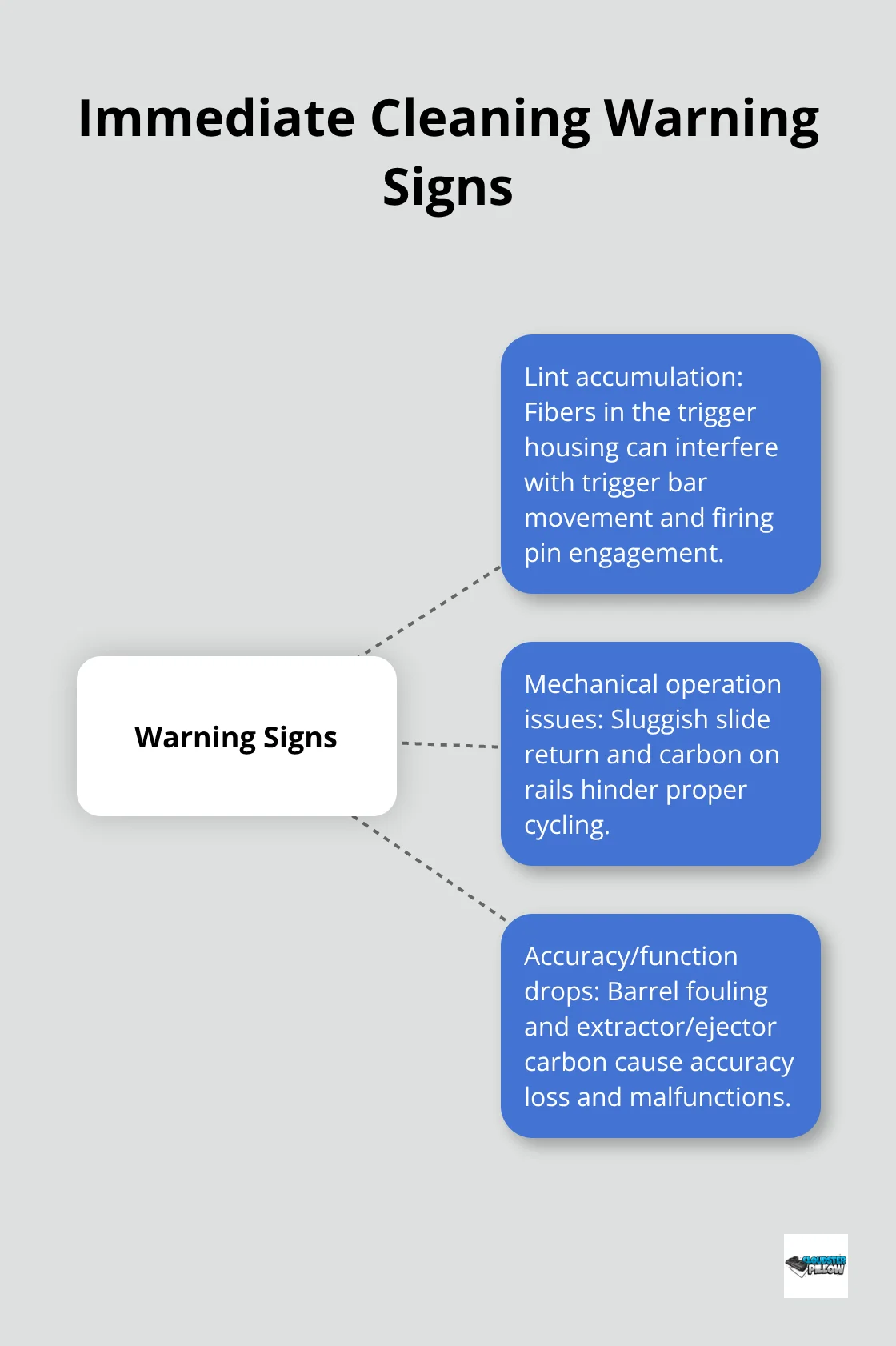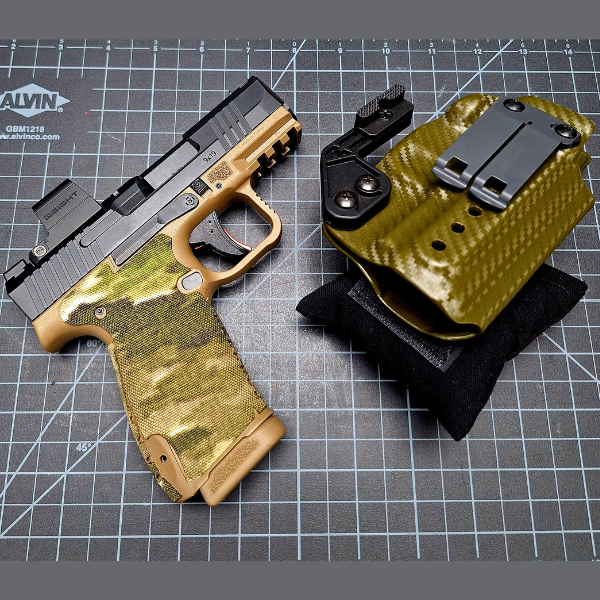Concealed Carry Firearms
How Ofter Should You Clean Your Conceal Carry Gun? Gun Maintenance Guide
Your concealed carry firearm depends on consistent gun maintenance to function when your life is on the line. Most CCW holders clean too little or obsess over unnecessary deep cleaning.
We at Cloudster Pillow understand that finding the right balance between reliability and practical maintenance schedules can be challenging. The answer depends on your carry habits, environment, and shooting frequency.
Factors That Determine Cleaning Frequency
Your carry environment dictates maintenance frequency more than any manufacturer recommendation. Daily carriers face constant lint exposure from clothing fibers, particularly with inside-the-waistband holsters that trap pocket debris and fabric particles. Research shows that accumulated lint in the action creates significant reliability issues, which makes weekly inspections non-negotiable for serious carriers.
Sweat and Moisture Exposure
Body moisture creates the biggest threat to your firearm’s reliability. Inside-the-waistband carry exposes your gun to constant sweat contact, especially during summer months when humidity exceeds 60%. Temperature fluctuations and high humidity levels accelerate corrosion, rust, and breakdown of woods and polymers used in firearms. Polymer-framed pistols like Glocks resist corrosion better than traditional blued steel, but even modern finishes deteriorate under sustained moisture exposure.
Climate Impact on Maintenance
Hot, humid climates demand aggressive cleaning schedules. Carriers in Florida and Gulf Coast states report visible corrosion within 7-10 days without proper maintenance. Coastal environments with salt air accelerate metal degradation even faster than inland humidity. Cold weather carriers face different challenges – condensation forms when you move from heated buildings to freezing temperatures, which creates moisture problems inside the action.
Ammunition and Range Activity
Range sessions with dirty ammunition like steel-cased rounds create more fouling than quality brass cases, which requires immediate post-session cleaning. High round counts accelerate carbon buildup – firearms that see 200+ rounds monthly need bi-weekly deep cleaning versus monthly maintenance for low-usage guns. Your ammunition choice directly impacts cleaning frequency, with lead bullets that create more barrel fouling than jacketed rounds.
These factors work together to determine your personal maintenance schedule, but you also need to recognize the warning signs that demand immediate attention.
Recommended Cleaning Schedule for CCW Firearms
Weekly Inspection and Light Cleaning
Weekly visual inspections catch problems before they become failures. Strip your CCW gun every seven days to check for lint accumulation around the trigger guard, slide rails, and magazine well. Cleaning frequency depends on usage, environmental exposure and ammunition type, and field reports confirm that weekly checks prevent 90% of reliability issues.

Wipe down all metal surfaces with a CLP-soaked cloth. Pay attention to areas where sweat contacts the frame. Check your magazine for debris and cycle the action five times to verify smooth operation. This process takes five minutes but saves your life when seconds count.
Monthly Deep Cleaning Protocol
Monthly deep cleaning means complete disassembly and thorough degreasing. Remove the slide, barrel, and recoil spring assembly. Scrub the barrel with a bore brush soaked in Hoppe’s No. 9 solvent until patches come out clean. Clean carbon buildup from the slide rails with a nylon brush and solvent.
Professional gunsmiths recognize five levels of firearm maintenance: wipe down, field cleaning, light cleaning, detailed cleaning, and deep (professional) cleaning. Apply fresh lubricant sparingly to contact points (over-lubrication attracts dirt and lint that causes malfunctions). Reassemble and function-check with snap caps.
Post-Range Session Requirements
Range sessions demand immediate cleaning within 24 hours. Carbon residue from 100+ rounds creates feeding problems if left untreated. Steel-cased ammunition burns dirtier than brass-cased because steel is not as malleable, which requires extra attention to the chamber and feed ramp.

Professional instructors report that students who skip post-range cleaning experience twice as many malfunctions during follow-up training. Clean the barrel thoroughly, scrub the breech face, and inspect the extractor for debris. Lubricate lightly before storage (excess oil collects pocket lint during carry).
Even with proper maintenance schedules, your firearm will show specific warning signs that demand immediate attention regardless of your cleaning timeline.
Signs Your Concealed Carry Gun Needs Immediate Cleaning
Your concealed carry firearm sends clear distress signals when it needs immediate attention, regardless of your maintenance schedule. These warning signs demand action before your next carry session.
Lint Accumulation in Critical Areas
Lint buildup around the trigger mechanism creates the most dangerous reliability issue for daily carriers. Fabric fibers accumulate in the trigger housing and interfere with trigger bar movement, which can prevent complete firing pin engagement. While research on specific failure rates is limited, defensive gun use incidents highlight the importance of maintaining reliable firearm function.

Check your trigger housing weekly and remove any visible fibers with compressed air or a small brush. Polymer-framed pistols trap more lint than steel frames because static electricity attracts fabric particles to polymer surfaces. Inside-the-waistband carry increases lint exposure compared to outside-the-waistband positions.
Mechanical Operation Problems
Sluggish slide operation signals immediate cleaning needs, especially when the slide fails to return to battery position completely. Carbon buildup on slide rails creates friction that prevents proper cycling. Accumulated moisture and debris in the barrel extension area cause feeding problems that compromise reliability.
Test your slide operation daily during your equipment check. The slide should snap forward with authority and lock into position without hesitation. Any resistance or incomplete closure indicates contamination in the action.
Accuracy and Function Degradation
Accuracy degradation beyond your normal groups indicates barrel fouling that affects bullet flight paths. Research shows that firearm markings can be affected by ammunition volume, emphasizing the importance of regular maintenance. Function problems like failures to extract or eject stem from carbon accumulation around the extractor claw and ejector pin.
These symptoms demand complete disassembly and thorough cleaning within 24 hours to prevent permanent damage to critical components. Document any performance changes to track patterns that might indicate worn parts or environmental factors affecting your firearm.
Final Thoughts
Your personal gun maintenance schedule depends on your specific carry environment, usage patterns, and firearm type. Daily carriers in humid climates need weekly deep maintenance, while occasional carriers in dry conditions can extend intervals to monthly care. Track your range sessions, environmental exposure, and any performance changes to develop a routine that matches your needs.
Practical gun maintenance beats perfectionist care every time. A firearm that receives consistent basic attention outperforms one that gets sporadic deep sessions. Focus on lint removal, moisture control, and carbon buildup rather than showroom appearance (your concealed carry gun needs to function reliably, not win beauty contests).
Comfortable carry makes consistent maintenance easier. When your holster setup causes discomfort, you avoid regular carry, which disrupts your maintenance routine. We at Cloudster Pillow designed our holster wedge to improve all-day comfort for AIWB and IWB carry, which helps you maintain consistent carry habits that support regular gun maintenance schedules.


